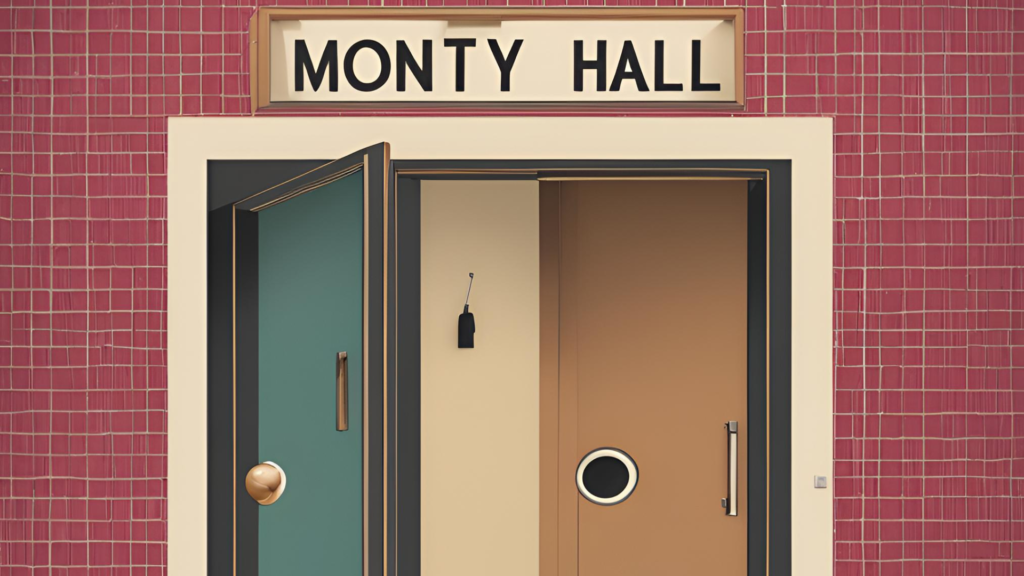How are you with probability theory? I’ll be honest, I was very bad at it. It requires, in my opinion, a bit of “inside-out” thinking. But if you can “turn it inside out,” it will be beneficial. It’s always useful to be able to look at a subject from different perspectives.
Let’s check it out. Monty Hall has nothing to do with probability theory; it’s the name of the host of the TV show “Let’s Make a Deal.” The most common version of the problem was published in Parade Magazine:
You are a game participant. In front of you are three doors, and you can open one of them. Behind one door is a car, and behind the other two are goats. You choose one door but have not opened it yet. After this choice, the host, Monty, opens one of the remaining doors. Since he is the host, he guarantees to open a door with a goat behind it. He knows where the car is. After this, he offers you to change your decision. Will your chances of success increase if you change your decision and choose a different door?
A normal person sees that there is a goat behind the open door. They have no additional information about what is behind the remaining doors. Therefore, they see no advantage in changing their choice. A normal person does not consider the fact that the host is guaranteed to open a door with a goat behind it. That is, he removes a knowingly bad option. The probability of initially choosing the correct door was 1/3, so after the host removes the bad choice, the likelihood that the car is behind the other door is now 2/3 (the sum of the possible probabilities always equals one). So, the chances of success double. Paradoxically, but true. If you don’t believe it, you’ll have to study this probability theory more closely. Pay attention to Bayes’ formula.
What relevance does this have to trading?
Let’s forget about the Monty Hall paradox for a moment. Initially, I believed that proper capital management meant that the take profit size should be 3-4 times larger than the stop loss size. Also, that the entry signal should work positively at least 70% of the time, or at least that’s what all signal providers promise. The fact remains that, at best, only 30% of retail clients do not lose their funds when working in the financial market. How to explain such an outcome, assuming that all 100% of clients at least encounter the possibility of using signals with guaranteed profit? I don’t know.
Now, let’s return to the paradox. Let’s assign the role of Monty to the market. It should be noted that to participate in this game, we create trading rules, the trading system. We are not discussing the rules themselves now; just accept that in the most ideal trading system, there are always moments when the market does not go as you want. But overall, we still have to win the car, not the goat. The only thing is that behind the doors, there isn’t always a whole car; very often, it’s a multi-level quest, and at each level, we might get another part of the car.
How is the system tested? First, we test it on historical data, then on a small amount of money in a real account. After that, we move on to normal amounts of money and experience disappointment because the system stops working. Or rather, it works, but only sometimes. We look for another system, repeat the cycle, and get the same result. Of course, this is the worst and most exaggerated outcome, but let’s understand why it happens and what can be changed.
As mentioned above, there is no ideal system. I have never seen statistical proof of the effectiveness of signals with specified risks and targets. What can be easily tracked is the number of consecutive unsuccessful market entries. Here the key word is “consecutive.”
Furthermore, when we test the system and expect a positive test, there is a possibility that as a result of these tests, the market has already opened all the doors with parts of cars for us, and only doors with goats are left. And despite all the system’s success, our chances are already predetermined and equal to zero.
Therefore, change your strategy. Analyze your system for the number of consecutive stop losses. When you start working and get a signal to act, don’t rush; remember, this is your initial choice. Let the market open the doors with goats, that is, sit in a waiting mode and wait for the system to fail. That is when the market does not as your rules tell you. This also won’t last forever, the market will return to your dynamics, and then you change your choice and will no longer wait but act.
This is not a grail, so the time it takes to build your car may be significantly longer than you’d like. To change this situation, you’ll need to “reverse” your thinking again. The market does not distribute parts evenly. Interpreting the Monty Hall paradox in the market context, when opening a door, we don’t always see a whole car; sometimes, we see just a part of it. And we close the door ourselves. If we wait a little longer, what is visible may turn into a goat. So, whether to wait or take the part of the car we already see is always our choice. The chances of finding a whole car behind the door immediately are negligible. Whether to assemble it piece by piece or in modules is our choice, which is called the skill of capital management.
To summarize, the quality of a trading system is determined by the simplicity of entry and exit signals and the strategic plan for growing profits. The first part should be as simple as possible. The second part is very difficult and highly individual since goals and levels are determined by you. Proportions are inapplicable here because they depend on the market’s volatility and liquidity at the moment, and changes in them lead to corresponding changes in proportions aligned with your plans. If this scares you, do not engage in trading. If it doesn’t:
“The road is made by walking.”
Best regards.



